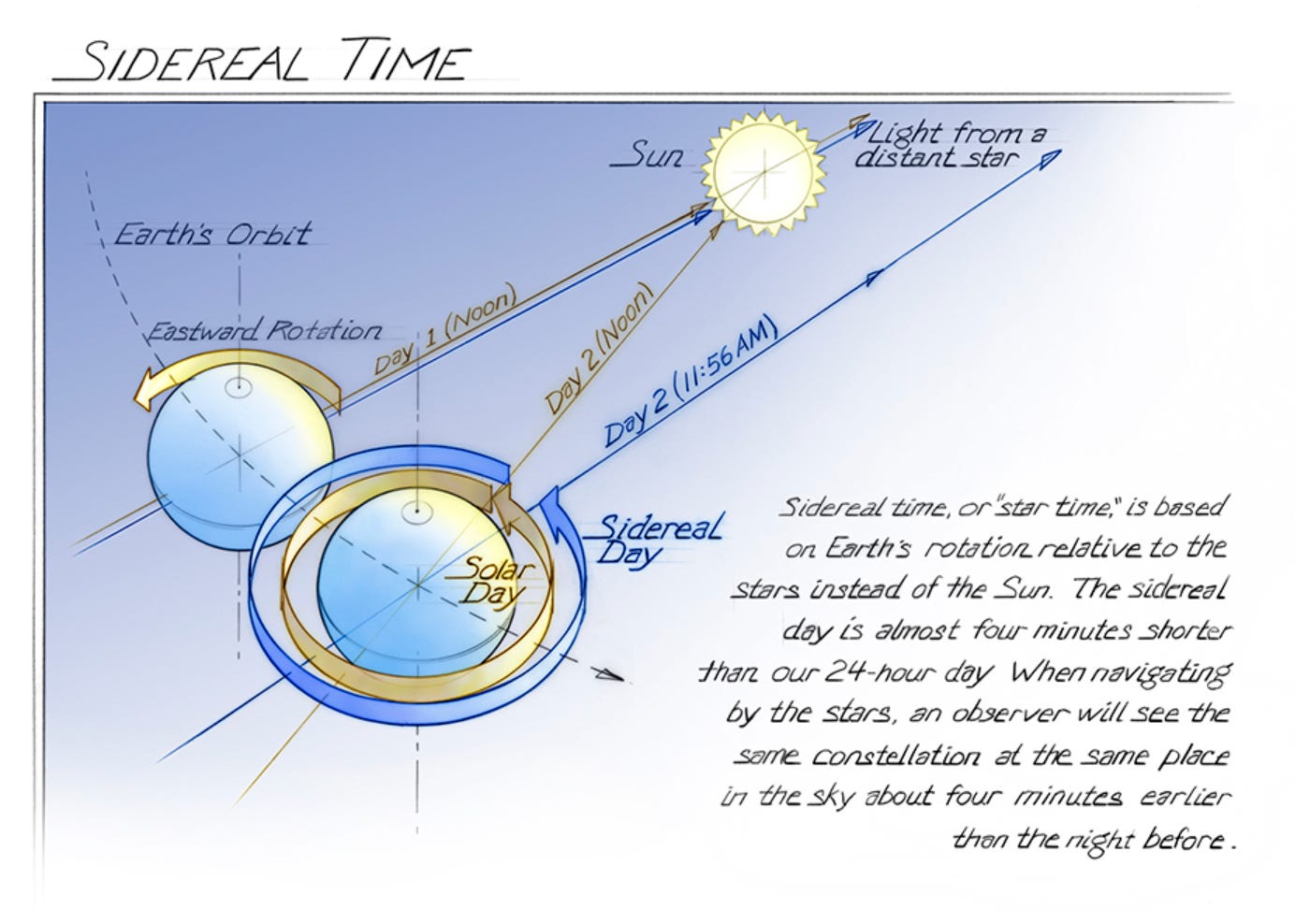september 24, 2024
There are different kinds of time.
To begin with... sidereal time is measured by the stars1.
The word comes from Latin sidereus, from sidus, sider- ‘star.’ Consider disaster2 is a way of saying: be with the stars, not against them!
The stars are reference points of light for measuring movement and distance.
Sidereal marks time that is star-based, rather than sun-based. Whereas our solar day is 24 hours, a sidereal day is 4 minutes less.
So what?
A little math: 4 minutes x 365 days= 1,460 minutes
1,460 minutes divided by 60 = 24 hours
After a year, the star location resets.
Constellations appear to rise earlier each night because Earth rotates on its axis 4 minutes earlier than a 24-hour day.
That’s why there are “winter constellations” and “summer constellations.” The stars rise twelve hours apart during opposite seasons.
The backdrop keeps shifting, rhythmically.
What about the moon?
Consideration from Latin considerare, "to look at closely, to observe"; literally, "to observe the stars"; from com-, "with" + sidussideris, "constellation."
An idea to consider: Lunar time is sidereal. Solar time is tropical.
This distinction, for some reason, is making these fireworks in my brain3.
Lunar time is sidereal.
There are the nakshatras, the manzils, mansions, lodgings, houses or lunar stations.
Sectors of stars measured along the ecliptic.
Lunar time is sidereal.
It is calculated and experienced through a relationship with asterisms and constellations.
Fixed stars that aren’t actually fixed. But will do.
Lunar time is sidereal.
The moon takes a journey through the star field every month.
A sidereal month 27.3 days … not 27 or 28 but somewhere in between.
Sometimes there’s an extra mansion, or a back-up nakshatra needed to fill the gap. As I understand it.
Solar time is tropical.
It's on the ecliptic plane. It is fixed to the equinoxes and the solstices - those are points where planes intersect.
Solar time is tropical.
Seasonally based on the ecliptic.
The tropical zodiac is solar. Not segments of stars, but ecliptical.
This is all coming into focus for me, but keeps blurring out in my own gaps of knowledge. So many ways of knowing.
Considering the vastness.
In the meantime I look to the sky to observe the bodies of light in proximity.
A nature practice. Unifying all cycles of time.
The nature of cycles.
To be continued…
xo April
Notes and References…
National Air and Space Museum, Smithsonian Institution
“Sidereal time, or “star time,” is based on Earth’s rotation relative to the stars, rather than to the Sun. The sidereal day is almost 4 minutes shorter than our 24-hour day.
When navigating by the stars, an observer will see the same constellation at the same place in the sky about four minutes earlier than the night before.”
Illustration by Bruce Morser 2012 https://timeandnavigation.si.edu/multimedia-asset/sidereal-time
Sounds True interview:
“Disaster means dis aster, ‘against the stars.’ Dis means ‘underworld,’ where our souls speak to us. The opposite, in our own language, is ‘consider.’ Con means ‘with,’ and sider is ‘the stars.’ When we pause to consider, we line up our inner and outer selves with the larger collaborative dance. We become agents of principles, rather than subject to laws.”
- Caroline W. Casey
https://resources.soundstrue.com/transcript/the-trickster-redeemer-woof-woof-wanna-play/
Inquiry sparked by Celestial Dew’s article: the ecliptic as a cultural practice and the reference to Vic DiCara’s work.










In the olden, pre-computer days, we learned to set up the chart doing the maths and using the ephemeris and tables of houses. I knew I was truly interested in becoming an astrologer when I, not a math person, was willing to do this! The word siderial reminds me of that time...now I surrender to Solar Fire. It made it much easier to calculate the lunar and solar returns and quickly see transets. But I have to admit that calculating the birth chart 'by hand' gave me an instant connection to the energy that was somehow deeper than the speedy, easy way.